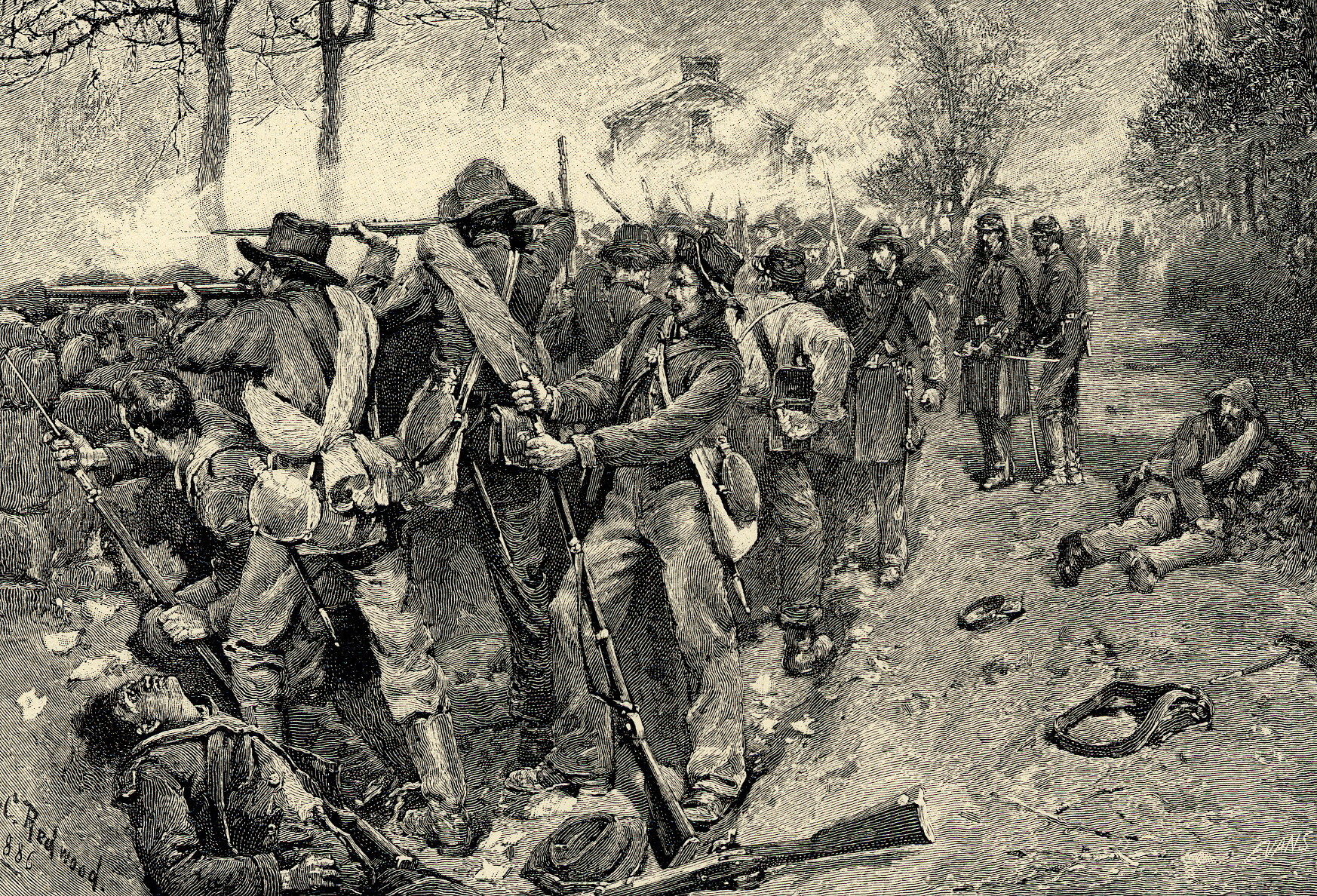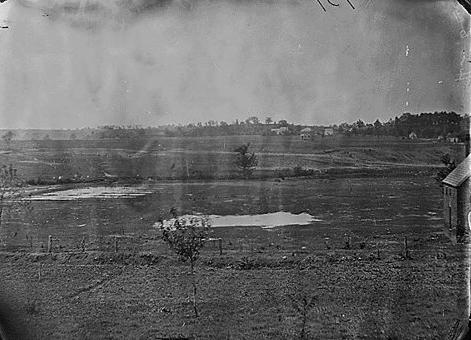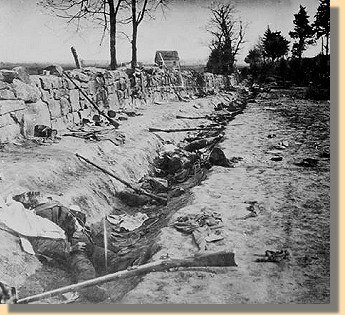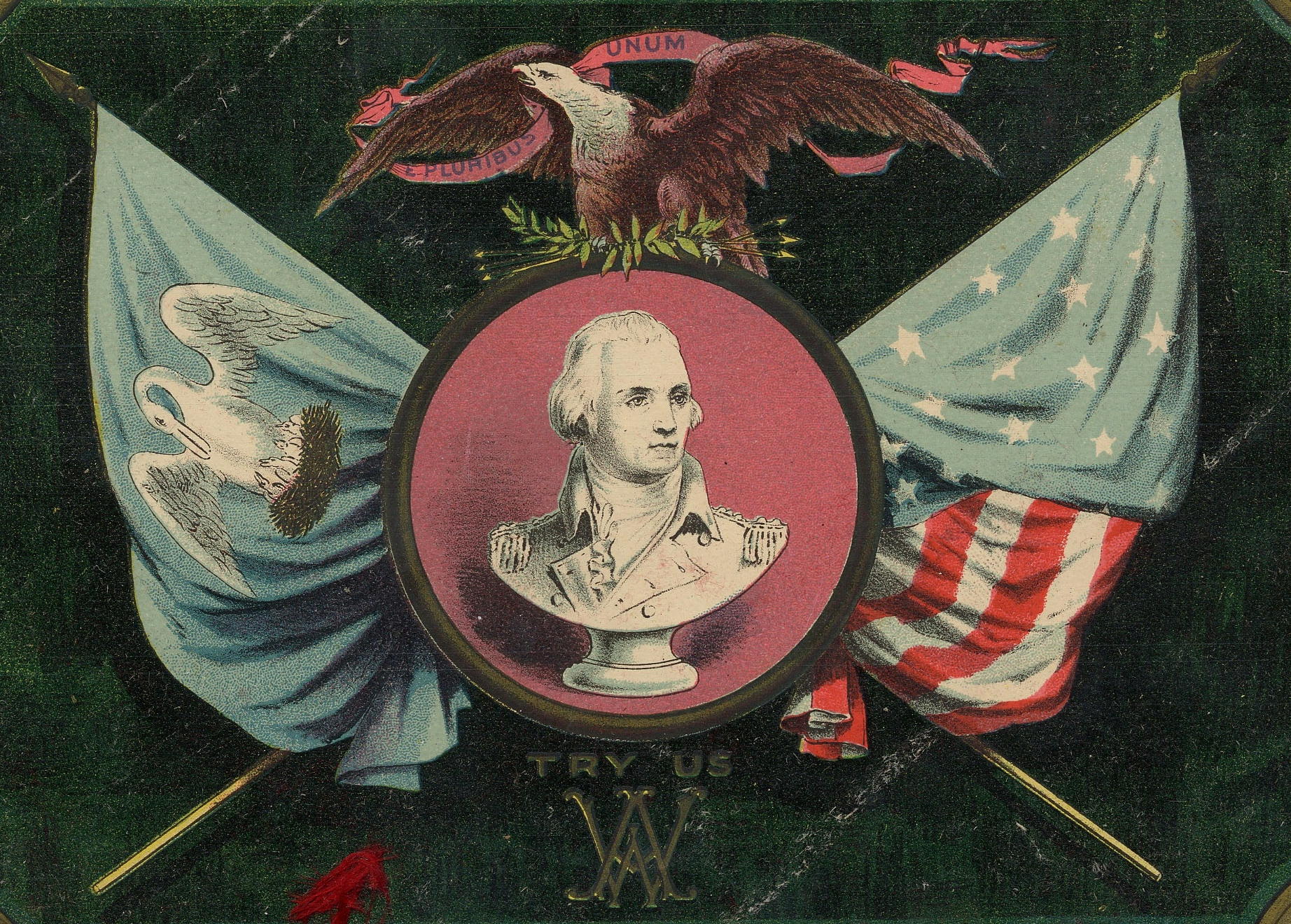Fredericksburg
The Washington Artillery at Mayre's Heights
An Eyewitness Account of Firing Upon the Enemy

The battle of
Fredericksburg took place on December 13, 1862. Union General Ambrose Burnside’s
Army of the Potomac numbering 130,000 men crossed the Rappahannock River on the
outskirts of Fredericksburg, Virginia to attack General Robert E. Lee’s
outnumbered (75,000 men) but well entrenched force along a ridge known as Mayre’s Heights. Despite the tactical Confederate advantage, Burnside ordered a
frontal assault upon the impregnable position. Packed behind a stone wall and a
sunken road at the base of the hill in ranks of four deep were the sons of
Georgia and Mississippi, awaiting the onslaught. Mayre’s Hill’s crest was
literally covered with the murderous guns of the Washington Artillery of New
Orleans. Col. E. Porter Alexander, chief of artillery to General Longstreet,
said to him before the battle, speaking of those guns and the plain they
commanded, “We will comb it as with a fine-toothed comb. A chicken could not
live on that field when we open fire.” Alexander
"felt the elation of a certain and easy victory."
This was because Confederates had time
to select their positions well and fortify them. Soldiers fashioned a crude
road up the rear of the heights to give the Confederates a covered access to
the hilltop. Southern artillery were placed on the tops of Willis Hill and
neighboring Marye's Hill. Captain Charles W. Squires of the Washington
Artillery posted two 3-inch rifled cannon in gun pits in front of the Willis
Cemetery and besides one of the several brick structures on the crest. The
Confederates hid their ammunition and horses behind the cover of the brick
wall enclosing the cemetery, and used one of the houses as their hospital.
The Union army of Ambrose E. Burnside
attacked on December 13, 1862 in a series of frontal assaults. Confederate
artillery fulfilled Alexander's prediction and killed Northerner infantry
soldiers in wholesale fashion. Federal artillery could not shake the
Confederate gunners from their fortifications. However, many of the Union
shells found their targets on Mayre's heights. One Confederate confessed
that "every inch of ground continually struck, apparently by bullets or
fragments of shells." The whitewashed brick house near Captain Squires'
cannon pits had been hit so many times by shells and bullets, that the
facade had changed from white to brick-dust red by afternoon.
The Washington artillerymen maintained
a steady fire. One participant related, "We who were able were speedily
working our guns with all our souls and bodies." Wave after wave of Union
troops melted away before the artillery and infantry fire "blown back as if
by the breath of Hell's Door suddenly opened." The ceaseless roar of the
cannon and musketry must have left a frightful sight to advancing Union
forces.

House at Mayre's Heights
General Longstreet recalled, “From the moment of their appearance began the most fearful
carnage; with our artillery from the front, right and rear, tearing through
their ranks, the Federals pressing forward with almost invincible determination,
maintaining their steady step and closing up their broken ranks. Thus resolutely
they marched upon the stone fence, behind which quietly waited the Confederate
brigade of General Cobb. As they came within reach of this brigade a storm of
lead was poured into their advancing columns, and they were swept from the field
like chaff before the wind. A cloud of smoke shut out the scene for a moment,
and rising revealed the scattered fragments recoiling from their gallant but
hopeless charge. The [Washington] artillery still plowed through their
retreating ranks, searched out the places of concealment into which the
retreating troops had plunged. … So the struggle went on. [Five times] the
Federals formed, charged and were repulsed. A sixth time they charged and were
driven back, when night came to end the dreadful carnage, and the Federals
withdrew, leaving the battlefield literally heaped with the bodies of their
dead." That day in 1862 proved to be a
Confederate victory.

Fredericksburg Battlefield
The field Union forces had to cross before
reaching Confederate forces in the distance.
(Mayre's Heights is distant hill with trees
upper right.)

Stone wall at Fredericksburg behind which
Confederate infantry took cover and fired upon Union advances.
Killing A Man -
An Eyewitness Account of A Confederate Infantryman
at Fredericksburg in 1862
The battle of Fredericksburg proved that well-positioned artillery could lay a
devastating deadly effect on the enemy from afar, but the infantry was still
needed to take physical control of the battlefield. The following is an infantry
soldier’s graphic recollection of the real and horrible reality of war as
written by an anonymous Confederate veteran and published in a New Orleans
newspaper after the war.
“They
do not call it murder when men meet to slaughter each other in battle. They
simply report so many dead, wounded and missing. When you fire into the smoke
concealing the other battle-line you fire in the hopes to kill or wound. It is
your duty. Battles cannot be won without killing, and the result of battles
changes the whole system of governments. You load and fire- load and fire - move
to the right or left - advance or retreat, and when the battle is over, you may
have fired fifty rounds and yet you have not had a near sight of the enemy; you
have simply fired at him, and you cannot vouch that one single of your bullets
has found a living target.
[But
then there is the emotional revelation of seeing one of those that you kill.]
Here is a brigade of us in battle line across an old meadow. We have erected
breastworks, and the enemy comes marching down upon us. Our [artillery] field
pieces behind us open fire on the enemy’s solid columns, but they are not
checked. Under the smoke we can see the effect of the shells, but they cannot
halt that mass of men. The grape and canister does awful execution, but there
should be a dozen guns behind us instead of six.
They
are going to charge us. Orders run along the line, and we are waiting until
every bullet, no matter if fired by a soldier with his eyes shut, must hit a
foe. I select my man while he is yet beyond range. I have eyes for no other. He
is a tall, soldierly fellow wearing the stripes of a sergeant. As he comes
nearer I imagine that he is looking as fixed at me as I at him. I admire his
coolness. He looks neither to the right nor to the left. The man on his right is
hit and goes down, but he does not falter.
I am
going to kill that man! I have a rest for my gun on the breastwork, and when the
order comes to fire I cannot miss him. He is living his last minute on earth! We
are calmly waiting until our volley shall prove a veritable flame of death. Now
they close up their gaps, and we can hear the shouts of their officers as they
make ready to charge. My man is still opposite me. He still seems to be looking
at me and no one else. I know the word is coming in a few seconds more, and I
aim at his chest. I could almost be sure of hitting him with a stone when we get
the word to fire. There is a billow of flame- a billow of smoke- a fierce crash,
and 4,000 bullets are fired into that compact mass of advancing men. Not one
volley alone, though that worked horrible destruction, but another and another,
until there was no longer a living man to fire at.
The smoke drifts
slowly away- men cheer and yell- we can see the meadow before us heaped up with
dead and dying men. We advance our line. As we go forward I look for my victim.
He is lying on his back, his eyes half shut and fingers clutching at the grass.
He grasps, draws up his legs and straightens them out again, and is dead as I
pass on. I have killed my man! My bullet alone struck him, tearing that ghastly
wound in his breast, and I am entitled to that honor. Do I swing my cap and
cheer? Do I point him out and expect to be congratulated? No! I have no cheers.
I feel no elation. I feel that I have murdered him, war or no war, and that his
agonized face will haunt me through the rest of my life.”
Fredericksburg,
May 3, 1863
Deja Vu?
The Washington Artillery defends Mayre's Heights
for a second time
.jpg)
Wrecked
caissons and dead horses left behind by the Washington Artillery at Marye's
Heights, Fredericksburg in 1863.
In May of 1863 the Union army's new
commander, General Joseph Hooker, advanced upon the Confederates at the same
location and fell into the the footsteps of his predecessor, Ambrose Burnside.
Here, his lieutenant general, John Sedgwick, proposed to attack the heights at
Fredericksburg in the same manner that had failed Burnside's army in December.
But this time the Confederates did
not have the same numerical force and were stretched across long lines of
defenses. The Washington Artillery held the same cannon pits as it did in 1862
with Captain Charles W. Squires stationed once more in front of Willis Cemetery.
As Sedgwick's federals massed before them on May 3, 1863, Lieutenant Colonel
William Miller Owen of the Washington Artillery remembered that "it was a
beautiful sight, but a terrible one for us."
The first Northern attack met with
the same onslaught as in December of 1862, and Union soldiers immediately fell
back to cover. However, this time Union artillery opened heavy cannon fire on
the hills' crests. Afterwards another Union assault caught the Confederates
overextended and Union infantry was able to penetrate the Confederate line at
the stone wall and up the ravine between Marye's and Willis' hills. Still, the
Washington Artillery continued to return fire at the federals.
On Mayre's Heights, Captain Miller's
Third Company Washington Artillery was under heavy fire as described by member
Henry Baker.
Mayre’s
Heights, Fredericksburg, Va., December 13, 1863
During
the hottest time of this engagement the Twenty-fifth North Carolina volunteers
reached the hill where Captain Miller’s Third Company of Washington Artillery
guns were planted and poured volleys into the lines of the advancing enemy;
then, dashing down the hill to the sunken road, stood shoulder to shoulder with
[Major Robert] Cobb’s brave Georgians. In passing through Miller’s guns, their
fallen bodies had to be dragged from our muzzles before they could be fired. Corporal
[Francis Dunbar] Ruggles had picked up a blanket which one of them had dropped
in Squire’s redoubt, saying, ‘Boys, this will be a good thing to have tonight.’
A few moments afterward with his sleeves rolled up and his youthful figure all
aglow with the excitement, holding his sponge-staff in his hand ready to ram the
cartridge home, he threw up his hands and fell backward, killed. … When the
gallant Ruggles is killed, [W.F.] Perry springs forward and seizes the
sponge-staff as it falls from poor Ruggles’ hands, but in an instant he is
disabled by a shot through the arm which drops helplessly to his side. [J.E.]
Rodd, who has been holding vent has his elbow shattered. [C.A.] Everett takes
his place and he also goes down disabled. He is laid in the corner of the
redoubt with Ruggles’ lifeless body, but fearless to the last, calls to the boys
to let him do something; ‘cut fuse if nothing else.’ Now [C.A.] Falconer, who
was passing back of the gun, is shot behind the ear, and falls a corpse. Poor
Ruggles- he used the blanket that night, but as a burial shroud.
Henry Baker, First
Company, WA
As the Union
troops swarmed around Captain Squires' First Company guns on Willis Hill, the Washington
artillerists kept "firing at the enemy until he came to the very muzzle of its
guns." A bloody hand-to-hand fight broke out over the guns until the Louisiana
gunners found themselves completely surrounded by soldiers of the 6th Maine
Volunteers. The Federals captured many of the Confederates along with six of the
Washington Artillery's cannon, their very first guns captured in battle. Among
those lost, Captain Squires was a prisoner along with both of his 3-inch Rifles. This time, Robert E. Lee was forced to retreat.
.jpg)
Burying the Confederate dead
following the second battle of Fredericksburg
.jpg)
Burying
the Confederate dead at Fredericksburg

HOME